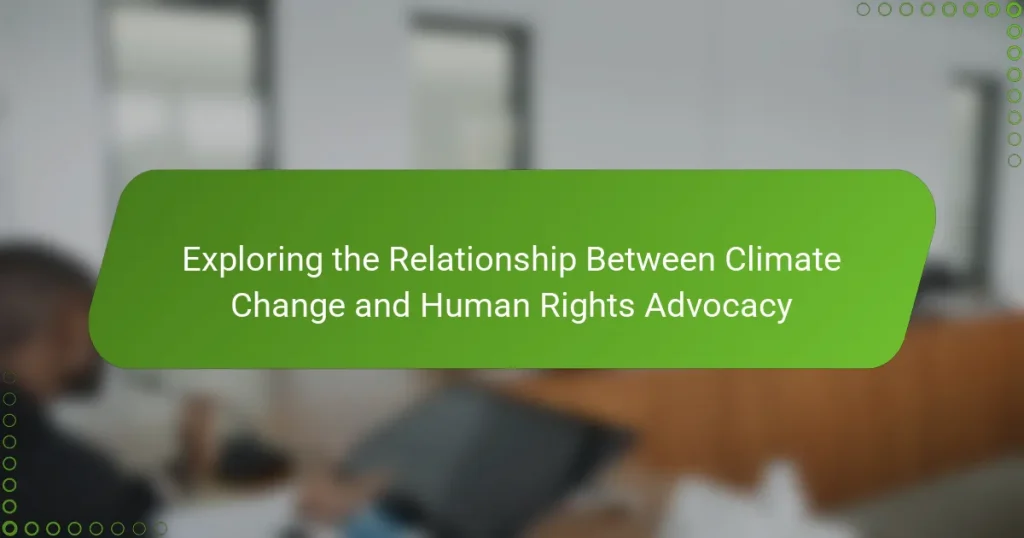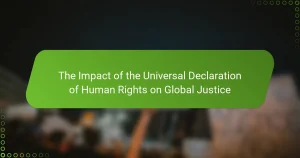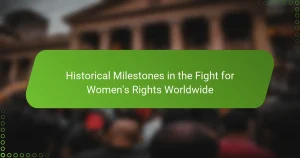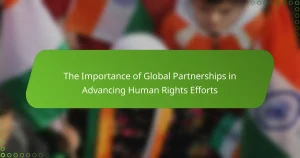Climate change significantly impacts human rights advocacy by threatening fundamental rights such as life, health, and access to clean water. The United Nations acknowledges climate change as a critical human rights issue, particularly affecting vulnerable populations like indigenous communities who face heightened risks. Displacement from climate events infringes on housing rights, while increased natural disasters jeopardize economic rights. This article explores the complex relationship between climate change and human rights advocacy, highlighting key challenges, actionable steps for strengthening advocacy, and the necessity of integrating human rights frameworks into climate policies. By addressing these issues, the article aims to enhance the effectiveness of advocacy efforts in mitigating the impacts of climate change on human rights.
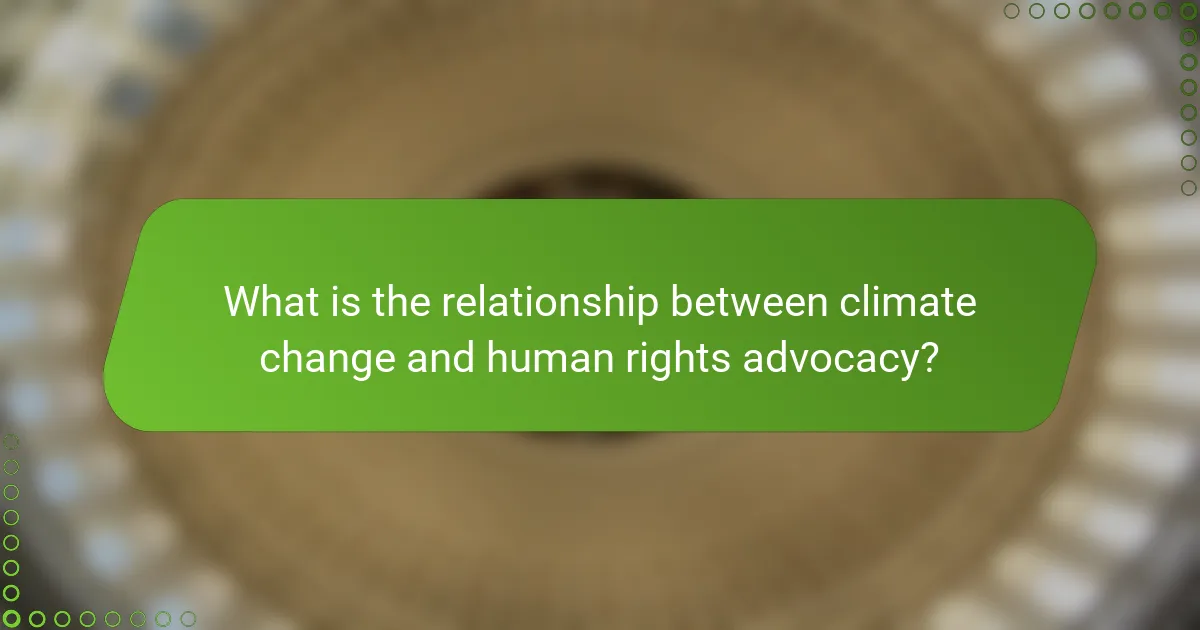
What is the relationship between climate change and human rights advocacy?
Climate change significantly impacts human rights advocacy. It affects fundamental rights such as the right to life, health, and access to clean water. The United Nations recognizes climate change as a threat to human rights. Vulnerable populations, including indigenous communities, face disproportionate risks. Displacement due to climate events infringes on the right to housing. Increased natural disasters can lead to loss of livelihood, violating economic rights. Advocacy efforts aim to hold governments accountable for climate policies. Human rights frameworks can guide climate action and promote justice.
How does climate change impact human rights?
Climate change significantly impacts human rights by threatening access to essential resources. It affects water availability, food security, and health. Extreme weather events displace communities and violate the right to housing. Vulnerable populations face increased risks of poverty and inequality. The United Nations recognizes climate change as a threat to human rights in its 2015 report. This report highlights how climate change exacerbates existing social injustices. For instance, marginalized groups often lack the resources to adapt. Thus, climate change creates a cycle of vulnerability and human rights violations.
What specific human rights are threatened by climate change?
Climate change threatens several specific human rights. These include the right to life, as extreme weather events can lead to loss of life. The right to health is also at risk due to the increase in heat-related illnesses and diseases. Additionally, the right to food is compromised by changing agricultural conditions and food scarcity. The right to water is threatened as droughts and flooding affect water availability. Furthermore, climate change impacts the right to housing, as communities may be displaced by rising sea levels and natural disasters. The right to work is endangered as industries reliant on natural resources face disruptions. Lastly, the right to participate in cultural life is affected when indigenous peoples lose their ancestral lands due to climate impacts. These threats are documented in various reports, including those by the United Nations and climate advocacy organizations.
How do marginalized communities experience climate change differently?
Marginalized communities experience climate change more severely than other groups. They face greater exposure to environmental hazards. Limited resources hinder their ability to adapt. These communities often live in vulnerable areas, such as flood-prone regions. Access to clean water and food security is also compromised. For example, Indigenous populations frequently lose traditional lands due to climate impacts. Studies show that low-income communities are disproportionately affected by extreme weather events. According to the Intergovernmental Panel on Climate Change, these disparities are linked to systemic inequalities.
Why is human rights advocacy important in the context of climate change?
Human rights advocacy is crucial in the context of climate change because it addresses the disproportionate impact of climate-related issues on vulnerable populations. Climate change exacerbates existing inequalities, affecting marginalized communities the most. These groups often lack the resources to adapt to environmental changes. Human rights advocacy seeks to ensure that these communities have a voice in climate policies. It emphasizes the right to a healthy environment as a fundamental human right. This approach can lead to more equitable climate solutions. By integrating human rights into climate action, advocates can hold governments accountable for their commitments. The Universal Declaration of Human Rights highlights the importance of dignity, which climate change threatens for many.
What role do human rights organizations play in addressing climate change?
Human rights organizations advocate for the recognition of climate change as a human rights issue. They highlight how climate change disproportionately affects vulnerable populations. These organizations work to ensure that climate policies consider human rights implications. They also promote accountability for environmental harm that violates human rights. For example, the UN Human Rights Council recognizes the right to a healthy environment. Human rights organizations often engage in legal actions to protect affected communities. They raise awareness through campaigns and reports on climate-related injustices. This advocacy helps to influence policy changes at national and international levels.
How can human rights frameworks enhance climate action?
Human rights frameworks can enhance climate action by ensuring accountability and promoting justice. These frameworks establish legal obligations for states to protect the rights of individuals affected by climate change. They empower marginalized communities to advocate for their rights in the context of environmental degradation. Human rights principles can guide climate policies, ensuring they are equitable and inclusive. For example, the Paris Agreement emphasizes the importance of human rights in climate action. This alignment can mobilize public support and increase political will. Furthermore, incorporating human rights can lead to more effective climate adaptation and mitigation strategies. Studies show that respecting human rights leads to better environmental outcomes.
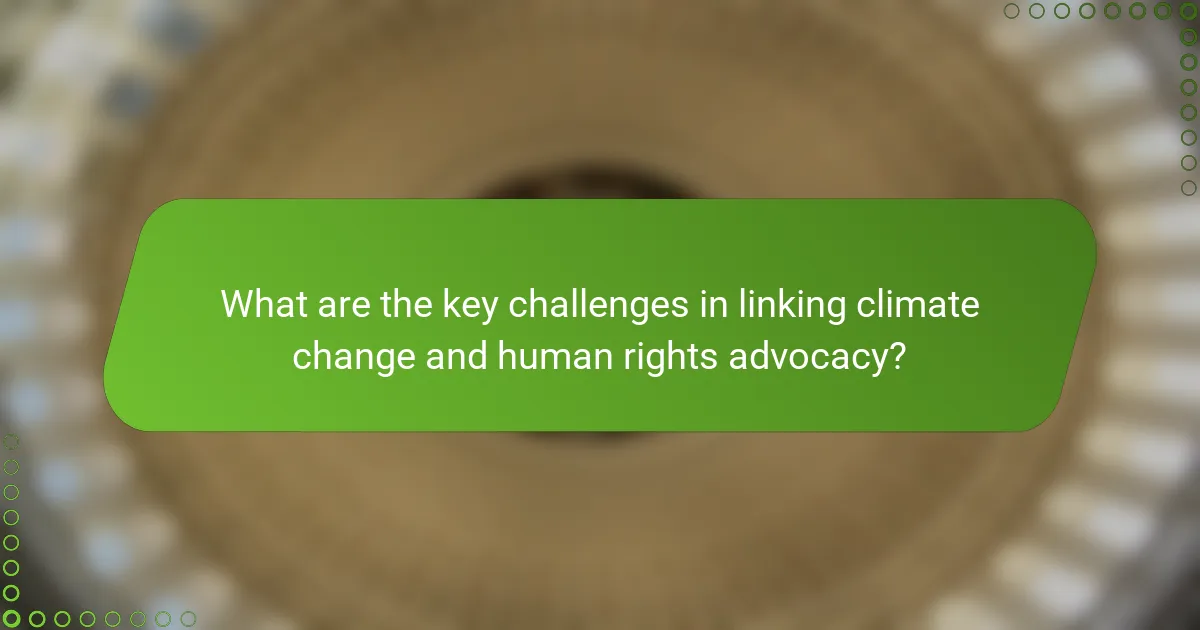
What are the key challenges in linking climate change and human rights advocacy?
The key challenges in linking climate change and human rights advocacy include the complexity of both issues. Climate change impacts are often indirect and long-term, making immediate human rights violations difficult to attribute. Additionally, there is a lack of legal frameworks that explicitly connect environmental harm to human rights abuses. Many vulnerable populations face disproportionate impacts from climate change, yet their voices are frequently marginalized in advocacy efforts. The intersectionality of climate change and human rights requires multidisciplinary approaches, which can complicate advocacy strategies. Furthermore, political and economic interests often hinder the integration of climate justice into human rights agendas. These challenges create barriers to effective collaboration between climate and human rights advocates.
What obstacles do advocates face in promoting human rights related to climate change?
Advocates face numerous obstacles in promoting human rights related to climate change. One major challenge is the lack of political will among governments to address climate issues. Many countries prioritize economic growth over environmental protection. This leads to insufficient policy measures that protect vulnerable populations.
Additionally, advocates encounter resistance from powerful industries that contribute to climate change. These industries often lobby against regulations that would mitigate their impact. This creates a significant barrier for advocates seeking to implement human rights protections.
Another obstacle is the difficulty in linking climate change directly to specific human rights violations. This connection can be complex and is often overlooked in legal frameworks. Furthermore, advocates may struggle to secure funding and resources for their initiatives. Limited financial support hampers their ability to raise awareness and drive change.
Public awareness of the intersection between human rights and climate change is also low. This lack of understanding makes it challenging for advocates to mobilize support. Overall, these obstacles hinder the effectiveness of human rights advocacy in the context of climate change.
How do political and economic factors hinder climate justice?
Political and economic factors hinder climate justice by creating imbalances in resource allocation and decision-making. Governments often prioritize short-term economic growth over long-term environmental sustainability. This leads to policies that favor industrial interests, neglecting vulnerable populations affected by climate change. Economic disparities result in unequal access to resources needed for climate adaptation and mitigation. Wealthier nations frequently evade accountability for their emissions, impacting global climate agreements. Furthermore, lobbying by powerful corporations can shape legislation against climate justice initiatives. Research shows that low-income communities bear the brunt of climate impacts due to systemic inequities. These factors collectively obstruct the pursuit of equitable climate solutions.
What are the limitations of current legal frameworks in protecting human rights amidst climate change?
Current legal frameworks often fail to adequately protect human rights in the context of climate change. Many laws do not specifically address climate-related human rights violations. This gap leaves vulnerable populations without necessary legal recourse. Additionally, existing frameworks may lack enforcement mechanisms to ensure compliance. The jurisdictional limitations of national laws can hinder international accountability. There is also a lack of recognition of climate change as a direct threat to human rights. Furthermore, legal definitions of harm may not encompass the long-term impacts of climate change. These limitations hinder effective advocacy and protection efforts for affected communities.
How can collaboration improve the relationship between climate change and human rights advocacy?
Collaboration can improve the relationship between climate change and human rights advocacy by aligning goals and resources. Joint efforts can amplify voices advocating for vulnerable populations affected by climate change. Collaborative initiatives can address the intersection of environmental degradation and human rights violations. This can lead to more comprehensive policies that protect both the environment and human rights. For instance, partnerships between NGOs and governments can enhance awareness and drive action. Research indicates that integrated approaches yield better outcomes in both climate resilience and human rights protection. Collaborative frameworks can also facilitate knowledge sharing and innovation in addressing these intertwined issues.
What partnerships are essential for effective advocacy?
Collaborative partnerships with NGOs, government agencies, and community organizations are essential for effective advocacy. NGOs provide expertise and resources that enhance advocacy efforts. Government agencies can facilitate policy changes and offer funding opportunities. Community organizations engage local populations, ensuring that advocacy reflects their needs. Academic institutions contribute research and data to support claims. Media partnerships amplify messages and raise public awareness. These collaborations create a unified front, increasing the impact of advocacy initiatives.
How can cross-sector collaboration enhance climate resilience and human rights protection?
Cross-sector collaboration can enhance climate resilience and human rights protection by integrating diverse expertise and resources. This approach fosters innovative solutions that address both climate challenges and human rights issues. For instance, partnerships between governments, NGOs, and private sectors can lead to comprehensive policies that protect vulnerable communities. Research shows that inclusive decision-making processes improve outcomes for marginalized populations. Additionally, sharing data and best practices across sectors can strengthen adaptive capacities. Effective collaboration can mobilize funding and technical support, enabling communities to better withstand climate impacts. Thus, cross-sector collaboration creates a synergistic effect, benefiting both climate resilience and human rights advocacy.
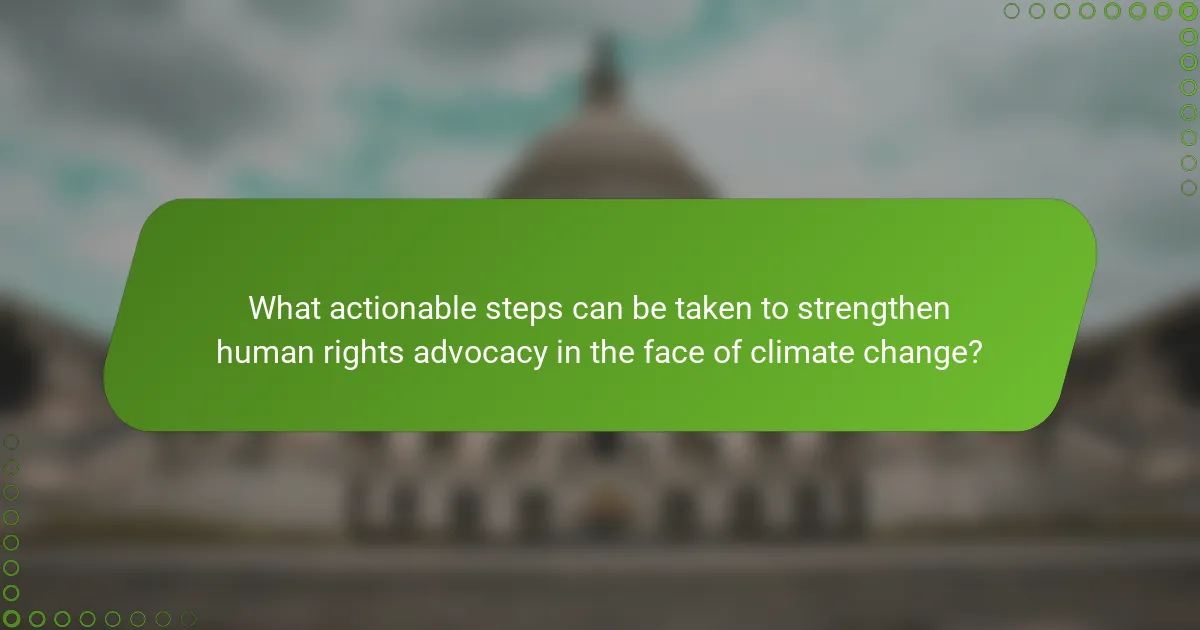
What actionable steps can be taken to strengthen human rights advocacy in the face of climate change?
Strengthening human rights advocacy in the face of climate change requires several actionable steps. First, integrate human rights frameworks in climate policies. This ensures that climate actions respect and protect human rights. Second, enhance public awareness about the intersection of climate change and human rights. Education campaigns can mobilize communities to advocate for their rights. Third, support vulnerable populations disproportionately affected by climate change. Targeted assistance can empower these communities. Fourth, foster partnerships between human rights organizations and environmental groups. Collaboration can amplify advocacy efforts. Fifth, promote legal accountability for climate-related human rights violations. This can deter harmful practices and support victims. Lastly, engage in international dialogues to influence global climate agreements. Participation can ensure human rights are prioritized in global climate strategies. These steps collectively enhance the effectiveness of human rights advocacy in addressing climate change impacts.
What best practices can organizations adopt to advocate for human rights in climate policies?
Organizations can adopt several best practices to advocate for human rights in climate policies. First, they should integrate human rights perspectives into climate action plans. This ensures that policies address the rights of vulnerable populations affected by climate change. Second, organizations must engage in multi-stakeholder dialogues. Collaboration with affected communities, governments, and civil society enhances policy effectiveness. Third, they should conduct impact assessments. These assessments identify potential human rights violations related to climate actions.
Additionally, organizations can promote transparency and accountability in climate governance. This builds trust and ensures that human rights considerations are prioritized. They should also provide training on human rights for policymakers and stakeholders. Educating these groups fosters a deeper understanding of the intersection between climate change and human rights. Finally, advocacy for legal frameworks that protect human rights in climate policies is crucial. This can lead to stronger enforcement mechanisms and better protection for affected individuals.
How can grassroots movements influence climate change legislation?
Grassroots movements can influence climate change legislation by mobilizing public support and raising awareness. They create a collective voice that can pressure lawmakers to act. These movements often engage in campaigns, protests, and advocacy efforts. They highlight the urgency of climate issues through local narratives. For example, the Sunrise Movement has effectively pushed for the Green New Deal in the U.S. Grassroots organizations can also build coalitions with other groups to amplify their message. Research shows that public demonstrations can lead to increased political engagement. This engagement often results in lawmakers introducing or supporting climate-related policies.
What strategies can be employed to raise awareness about the human rights implications of climate change?
Education and outreach programs can effectively raise awareness about the human rights implications of climate change. These programs can inform communities about how climate change disproportionately affects vulnerable populations. Hosting workshops and seminars can facilitate discussions on this topic. Collaborating with local organizations can enhance outreach efforts and provide resources. Social media campaigns can amplify messages and reach a broader audience. Engaging in storytelling through personal narratives can humanize the issue. Mobilizing youth activism can foster a new generation of advocates. Research shows that informed communities are more likely to advocate for policy changes that protect human rights in the context of climate change.
What resources are available for advocates working at the intersection of climate change and human rights?
Advocates working at the intersection of climate change and human rights can access various resources. Key resources include reports from organizations like Human Rights Watch and Amnesty International. These reports provide insights into the impacts of climate change on vulnerable populations. Additionally, the United Nations Framework Convention on Climate Change offers guidelines for integrating human rights into climate action. Training programs from the Climate Reality Project equip advocates with skills to address these issues effectively. Online platforms like the Climate Justice Alliance provide networking opportunities and collaborative tools. Research papers from academic institutions also contribute valuable data on this intersection. These resources collectively support advocates in their efforts to promote human rights in the context of climate change.
Which organizations provide support for climate justice initiatives?
Organizations that provide support for climate justice initiatives include the Sierra Club, Greenpeace, and the Climate Justice Alliance. The Sierra Club focuses on grassroots advocacy and mobilizing communities for environmental justice. Greenpeace conducts campaigns to raise awareness about climate change and its impact on marginalized communities. The Climate Justice Alliance aims to build a movement that connects climate change with social justice issues. These organizations work collaboratively with affected communities to promote equitable solutions to climate challenges.
How can individuals contribute to human rights advocacy in the context of climate change?
Individuals can contribute to human rights advocacy in the context of climate change by raising awareness and promoting education on the issue. They can engage in community discussions and share information through social media platforms. Supporting organizations that focus on climate justice is another effective way to contribute. Volunteering time or resources to these organizations amplifies their impact. Individuals can also advocate for policy changes by contacting local representatives. Participating in climate marches and events helps to demonstrate public support for human rights in climate action. Research indicates that grassroots movements significantly influence policy decisions and public opinion. The 2019 Global Climate Strike mobilized millions worldwide, showcasing the power of collective action.
The main entity of the article is the relationship between climate change and human rights advocacy. The article explores how climate change threatens fundamental human rights, particularly for vulnerable populations, and highlights the role of human rights advocacy in addressing these issues. It discusses specific rights impacted by climate change, the challenges faced by marginalized communities, and the importance of integrating human rights frameworks into climate action. Additionally, the article outlines actionable steps for strengthening advocacy efforts and emphasizes the need for collaboration among various stakeholders to enhance climate resilience and protect human rights.
